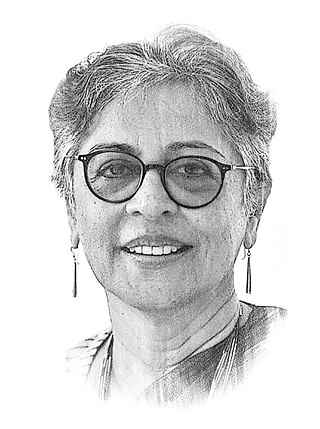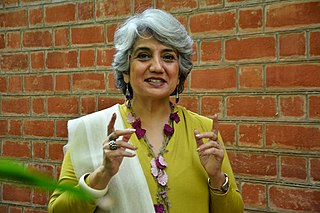Anupama Kundoo | |
|---|---|
 Anupama Kundoo in 2016 | |
| Born | 24 April 1967 Pune, India |
| Nationality | Indian |
| Occupation(s) | Architect , Professor |
| Years active | 1990–present |
Anupama Kundoo (born in Pune in 1967) is an Indian architect.
Anupama Kundoo | |
|---|---|
 Anupama Kundoo in 2016 | |
| Born | 24 April 1967 Pune, India |
| Nationality | Indian |
| Occupation(s) | Architect , Professor |
| Years active | 1990–present |
Anupama Kundoo (born in Pune in 1967) is an Indian architect.
Anupama Kundoo studied architecture at the Sir J. J. College of Architecture, University of Bombay and received her degree in 1989. She was awarded the Vastu Shilpa Foundation Fellowship in 1996 for her thesis on "Urban Eco-Community: Design and Analysis for Sustainability". She got her doctoral degree from the Technical University of Berlin in 2008. [1] [2]
Kundoo established herself as an architect in Auroville in 1990 where she designed and built many buildings with "energy and water efficient infrastructure" adaptations. [3] She worked here from middle of 1990 till 2002. [4]
Kundoo taught at the Technical University, Berlin, and Darmstadt in Hesse during 2005. [5] She worked as Assistant Professor at Parsons The New School for Design, New York [2] until 2011 then moving to Australia as a senior lecturer in the University of Queensland. In 2014, she shifted to Europe and began working at the European School of Architecture and Technology at the Universidad Camilo José Cela in Madrid. [6]
Her approach to building design is based on material research that minimizes environmental effects. [3] Her basic design approach is to use "waste materials, unskilled labour and local communities". [7]
One of the notable buildings built for her own residence is titled the "Wall House", built in a community area of 15 acres (6.1 ha) with a built-in space of 100 square metres (1,100 sq ft) constructed for one million Rupees in 2000, [3] in Auroville for communal living. [8] This house is L-Shaped in the plan, has a courtyard in the middle; while it is modern in concept it adopts traditional "vernacular" use of materials such as compressed earth, concrete, and steel. The bathroom is set in an open-to-sky design, with smooth merging with the interior and external spaces and landscaped, giving it both a modern and a regional appearance. [9] A full-sized replica of her Wall House was made by hand and exhibited at the Venice Biennale of Architecture. [4] New York Times called it as "a gem among rubble".
Another of her theme is "Liberty" which presents a reading place as a free library, a creation built with three types of trees fixed in the centre of a square space. The trees' trunks and branches are made from steel and the leaves made of salvaged books, with the floor made of concrete. This was exhibited at the Placa de Salvador Segui in Barcelona during June–September 2014. [10]

Charles Mark Correa was an Indian architect and urban planner. Credited with the creation of modern architecture in post-Independent India, he was celebrated for his sensitivity to the needs of the urban poor and for his use of traditional methods and materials.

Yasmeen Lari is Pakistan's first female architect. She is best known for her involvement in the intersection of architecture and social justice. Since her official retirement from architectural practice in 2000, her UN-recognized NGO Heritage Foundation Pakistan has been taking on humanitarian relief work and historical conservation projects in rural villages all around Pakistan. She was awarded the prestigious Fukuoka Prize in 2016 and the RIBA's Royal Gold Medal in 2023.

Auroville is an experimental township in Viluppuram district, mostly in the state of Tamil Nadu, India, with some parts in the Union Territory of Pondicherry in India. It was founded in 1968 by Mirra Alfassa and designed by architect Roger Anger.

Kiran Desai is an Indian author. Her novel The Inheritance of Loss won the 2006 Man Booker Prize and the National Book Critics Circle Fiction Award. In January 2015, The Economic Times listed her as one of 20 "most influential" global Indian women.

Benedetta Tagliabue is an Italian architect, who lives and works in Barcelona, Spain. Tagliabue was born in Milan, Italy. She graduated from the Istituto Universitaria di Architettura di Venezia in 1989. She is an internationally renowned architect founder with Enric Miralles (1955–2000) of the international studio EMBT Architects, with offices in Barcelona (HQ), Shanghai, and Paris. She is renowned for her attentiveness to context, yet experimental, approach to forms and materials in her creations. Her Barcelona-based company EMBT has become one of the most renowned Spanish practices of the 21st century as a result of her varied and intricate works.

Anupama Chopra (née Chandra) is an Indian author, journalist and film critic who serves as the director of the MAMI Mumbai Film Festival. She is also the founder and editor of the digital platform Film Companion, which offers a curated look at cinema. She has written several books on Indian cinema and has been a film critic for NDTV, India Today, as well as the Hindustan Times. She also hosted a weekly film review show The Front Row With Anupama Chopra, on Star World. She won the 2000 National Film Award for Best Book on Cinema for her first book Sholay: The Making of a Classic. She presently critiques movies and interviews celebrities for Film Companion.
Joseph Stein was an American architect and a major figure in the establishment of a regional modern architecture in the San Francisco Bay area in the 1940s and 1950s during the early days of the environmental design movement. In 1952, he moved to India and in 1955 was tasked with the planning of Durgapur in West Bengal, India along with Benjamin Polk. He was commissioned with this task in order to facilitate the establishment of Durgapur Steel Plant later on in 1959 followed by the Durgapur Steel City and Township. He is noted for designing several important buildings in India, most notably in Lodhi Estate in Central Delhi, nicknamed "Steinabad" after him, and where today the 'Joseph Stein Lane', is the only road in Delhi named after an architect. He is also famous for being the architect of the scenic Indian Institute of Management Kozhikode's campus. The Government of India awarded him the fourth highest civilian award of Padma Shri in 1992. His works remain even more relevant in the modern context as need for sustainable and humane architecture is felt.

Roger Anger was a French architect who worked on the Auroville project, designed by Mirra Alfassa and endorsed by UNESCO and the Government of India. He also collaborated many times with Pierre Puccinelli, notably on the Île Verte in Grenoble.

The Indian Institute of Architects (IIA) is the professional national body of architects in India. It was established in 1917 with its headquarters in Mumbai, India. It is associated with the International Union of Architects (UIA) Commonwealth Association of Architects (CAA) and South Asian Association for Regional Cooperation of Architects (SAARCH).

Brinda Somaya is an Indian architect and urban conservationist.
Indian Architect & Builder (IA&B) is an architecture magazine in India. Published in Mumbai, India by Jasubhai Media Pvt. Ltd, the magazine was started in 1986. It is one of the oldest publications on architecture and design practices in India. The magazine had featured works from some of the most significant architecture practices in India having an extensive archive of projects and writings.

Bimal Hasmukh Patel is an architect from Ahmedabad, India, with over 35 years of professional, research and teaching experience in architecture, urban design and urban planning. He is President of CEPT University in Ahmedabad and leads HCP Design Planning and Management Private Limited, an architecture, planning and project management firm. He also founded Environmental Planning Collaborative, a not-for-profit, planning research and advocacy organization.
Samira Rathod is an Indian architect, furniture designer, writer, and teacher based in Mumbai. She is a Principal of Samira Rathod Design Associates.
Shimul Javeri Kadri is an Indian architect who is the founder of SJK Architects, an architectural firm in the city of Mumbai, India.
Chitra Vishwanath is an Indian architect based in Bengaluru who works on themes related to ecology and architecture. She has been running her own architectural firm since 1991, working with other architects on many projects in India and Africa.
Hema Sankalia (1934–2015) was one of the first female architects in India.

Aishwarya Tipnis is an Indian architect, educator and heritage conservationist, whose eponymous practice Aishwarya Tipnis Architects focuses on heritage conservation of neglected monuments and significant buildings of India. In 2015, her work on the century-old Main Building of The Doon School received the Honourable Mention under the UNESCO Asia-Pacific Awards for Cultural Heritage Conservation. In 2016, the firm's restoration work on the walls and bastions of the 18th-century Mahidpur Fort, in Madhya Pradesh, was given the Award of Merit under the UNESCO Asia Pacific Heritage Awards. In 2018, she became the youngest architect to be appointed the Chevalier de l'Ordre des Arts et des Lettres by the French government for her preservation work of French heritage in India, particularly Chandernagore in West Bengal. Tipnis was part of the UNESCO Expert Team for preparing the Comprehensive Conservation Plan for the Darjeeling Himalayan Railway, a UNESCO World Heritage Site. She has been recognised as a Global Cultural Leader by the European Union in 2016.

Deepika Kundaji is an Indian farmer whose methods gained national attention and an award from the Government of India. The Nari Shakti Puraskar award was made by the President of India, Ram Nath Kovind. The award is India's highest civilian award for women.

Canna Hasmukh Patel is an Indian architect and interior designer based in Ahmedabad. Patel is also a visiting faculty at CEPT University and also works as a guide for the various architecture students at CEPT. Detailing and integration of art in her interiors and architecture are trademarks of her work. Patel firmly believes in simplicity and a holistic link between Interiors & Architecture.
Atmaram Mancharam Gajjar (1901-1961) was an Indian architect from Ahmedabad, Gujarat.